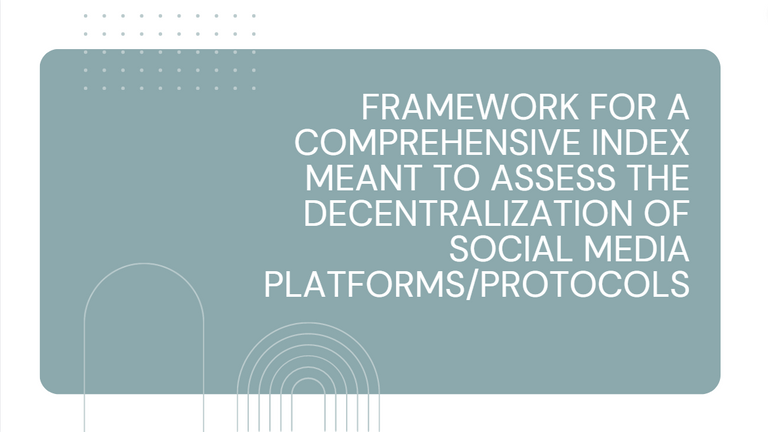
INTRO:
This paper was written as a response to the many lies and misrepresentations present in the crypto ecosystem where uninformed users and investors are trapped by project owners lying about the attributes of their projects. This was inspired by @scottcbusiness decentralization matrix made a few years ago. Decentralization being one of those attributes. I saw @jongolson ping me today in a post discussing the topic of Coingecko posting that absurd and laughable graphic on Twitter so I said to myself:
Why not make a tool that might help determine a level of decentralization of certain projects.
So here it is. As a note... I wrote this in 4 hours. To write a framework for an Index on par with what you see in research papers would take many more hours of research and work. This is just a basis from which we can go forward and expand. Ill be taking payments in hugs and kisses to finish this.
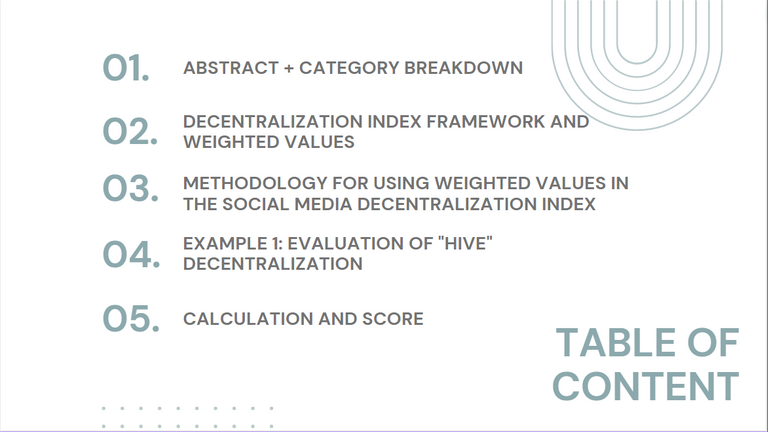
Abstract
This paper presents a framework for a comprehensive index designed to evaluate the decentralization levels of social media platforms in the blockchain/crypto ecosystem with the intent of offering investors and users a clear understanding of WEB3 aligned platforms by addressing the underlying attributes of each of them in a space where certain platforms are known to misrepresent the features of their projects.
This method will be presented publicly, will be repeatable and reproducible.
Decentralization in this context encompasses various categories, including governance structure, data ownership, content moderation policies, censorship resistance, open-source development, node distribution, token/wealth distribution, and transacting capabilities.
The index comprises multiple indicators for each category, quantifying different dimensions of decentralization. Weighted scores are calculated based on these indicators, providing a holistic assessment of decentralization for individual platforms. My hope is that the index will serve as a valuable tool for investors, policymakers, and users interested in understanding and comparing the decentralization features of various social media platforms.
CATEGORY BREAKDOWN AND EXPLANATION:
Category 1: Governance Structure
This category focuses on the decision-making process and transparency in governance decisions. Indicator 1 evaluates the presence of a distributed decision-making process, which refers to whether decision making power is decentralized among multiple stakeholders. Indicator 2 measures the transparency of governance decisions, indicating the extent to which the platform provides clear, frequent and accessible information about its governance processes and decision-making.
Category 2: Data Ownership
This category examines the level of ownership and control that users have over their accounts and the security measures implemented by the platform in regards to account ownership. Indicator 1 assesses the extent to which users has control over their accounts while considering the power the platform has over user account deletion. Can the platform affect user account ownership in any way? Indicator 2 evaluates the security measures implemented by the platform to protect user accounts from unauthorized access and breaches.
Category 3: Content Moderation Policies
This category focuses on the platform's content moderation policies, considering the involvement of the community and the transparency and clarity of moderation guidelines. Indicator 1 examines whether the platform employs community moderation, enabling users to participate in content moderation processes. Indicator 2 evaluates the transparency of moderation guidelines, indicating the clarity and accessibility of the platform's guidelines for content moderation.
Category 4: Censorship Resistance and Free Speech
This category evaluates the platform's resistance to government-imposed censorship and the potential for censorship or removal by the platform itself. Indicator 1 assesses the platform's resilience against government-imposed censorship, taking into account measures to protect user-generated content from external censorship. Indicator 2 examines whether the platform has the authority to censor, ban, or remove users or content, potentially impacting freedom of speech and expression.
Category 5: Open-Source Development
This category assesses the extent to which the platform embraces open-source principles, community involvement in development, and the availability and quality of development resources and documentation. Indicator 1 examines whether the platform utilizes open-source software. Indicator 2 evaluates the level of community involvement in the platform's development processes. Indicator 3 assesses the availability of development resources and documentation, and ease of access to them which facilitates community participation and innovation.
Category 6: Node Distribution
This category focuses on the distribution and diversity of nodes in the platform's network, as well as incentives for running nodes. Indicator 1 assesses the number of independent nodes in the platform's network, indicating the degree of decentralization. Indicator 2 evaluates the geographic diversity of nodes, considering their distribution across different regions. Indicator 3 examines the presence of incentives, such as rewards to encourage users to run nodes and contribute to network stability.
Category 7: Token/Wealth Distribution
This category evaluates the distribution of tokens or wealth among stakeholders and non-staked holders within the platform's ecosystem and the mechanisms in place to address wealth inequality. It also asses if there was an ICO and a distribution towards the team/dev structure with indicator 1. Indicator 2 assesses the distribution of tokens, considering factors such as token allocations and wealth concentration. Indicator 3 evaluates the presence of mechanisms within the platform to address wealth inequality, such as token redistribution and contribution incentives via a DAO, or else.
Category 8: Transacting
This category focuses on the platforms support for seamless and interference free transactions. Indicator 1 assesses the ability to transact freely without platform interference, indicating whether the platform imposes restrictions or limitations on user transactions. Indicator 2 evaluates the level of liquidity availability for the specific token which is intended to show ability to easily exchange in and out of the system. Higher scores assigned to token listings on top 10 centralized exchanges and based on trading pair liquidity on DEXes.
DECENTRALIZATION INDEX FRAMEWORK AND WEIGHTED VALUES
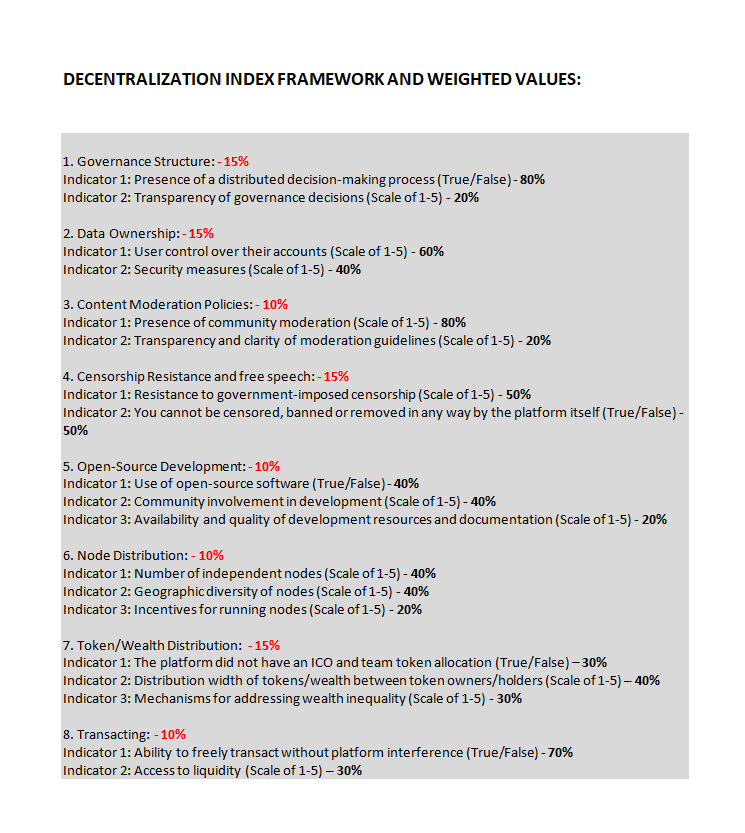
1. Governance Structure: - 15%
Indicator 1: Presence of a distributed decision-making process (True/False) - 80%
Indicator 2: Transparency of governance decisions (Scale of 1-5) - 20%
2. Data Ownership: - 15%
Indicator 1: User control over their accounts (Scale of 1-5) - 60%
Indicator 2: Security measures (Scale of 1-5) - 40%
3. Content Moderation Policies: - 10%
Indicator 1: Presence of community moderation (Scale of 1-5) - 80%
Indicator 2: Transparency and clarity of moderation guidelines (Scale of 1-5) - 20%
4. Censorship Resistance and free speech: - 15%
Indicator 1: Resistance to government-imposed censorship (Scale of 1-5) - 50%
Indicator 2: You cannot be censored, banned or removed in any way by the platform itself (True/False) - 50%
5. Open-Source Development: - 10%
Indicator 1: Use of open-source software (True/False) - 40%
Indicator 2: Community involvement in development (Scale of 1-5) - 40%
Indicator 3: Availability and quality of development resources and documentation (Scale of 1-5) - 20%
6. Node Distribution: - 10%
Indicator 1: Number of independent nodes (Scale of 1-5) - 40%
Indicator 2: Geographic diversity of nodes (Scale of 1-5) - 40%
Indicator 3: Incentives for running nodes (Scale of 1-5) - 20%
7. Token/Wealth Distribution: - 15%
Indicator 1: The platform did not have an ICO and team token allocation (True/False) – 30%
Indicator 2: Distribution width of tokens/wealth between token owners/holders (Scale of 1-5) – 40%
Indicator 3: Mechanisms for addressing wealth inequality (Scale of 1-5) - 30%
8. Transacting: - 10%
Indicator 1: Ability to freely transact without platform interference (True/False) - 70%
Indicator 2: Access to liquidity (Scale of 1-5) – 30%
Methodology for Using Weighted Values in the Social Media Decentralization Index:
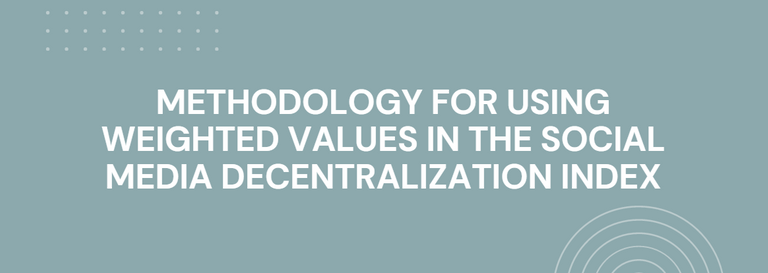
The Social Media Decentralization Index incorporates weighted values to assign importance to different categories and indicators in assessing the decentralization of social media platforms. The methodology involves the following steps:
a) Category definition: The index consists of eight categories that capture various aspects of decentralization in social media platforms. These categories were carefully chosen to encompass key dimensions such as governance structure, data ownership, content moderation, censorship resistance, open-source development, node distribution, token/wealth distribution, and transacting capabilities.
b) Indicator Definition: Within each category, specific indicators were defined to quantify and evaluate relevant factors. Each indicator focuses on a particular aspect of the category, providing measurable criteria for assessment.a) Category scoring: Weights were assigned to each category to reflect their relative importance in assessing decentralization. These weights represent the proportionate contribution of each category to the overall index. The weights were determined based on careful consideration while taking into account the significance of each category in determining decentralization.
b) Indicator Scoring: For each indicator, a specific scoring method was defined. This could involve binary (True/False) = (0 or 5) responses, rating scales, or a combination of both. Scoring criteria were designed to capture the varying degrees or qualities of decentralization.a) Calculation of Weighted Scores: Weighted scores for each indicator were calculated by multiplying the indicator's raw score by the weight assigned to its respective category. These weighted scores reflect the contribution of each indicator to its corresponding category and, in turn, to the overall index.
b) Overall Index Calculation: The overall index score for a social media platform was obtained by summing up the weighted scores across all categories and indicators. This cumulative score provides a comprehensive measure of the platform's decentralization level, considering the combined impact of all evaluated factors.
By utilizing the weighted values and methodology described above, the Social Media Decentralization Index enables a systematic and standardized evaluation of social media platforms, facilitating comparisons and insights into their decentralization characteristics.
EXAMPLE 1: HIVE
Evaluation of Hive's Decentralization Using the Social Media Decentralization framework
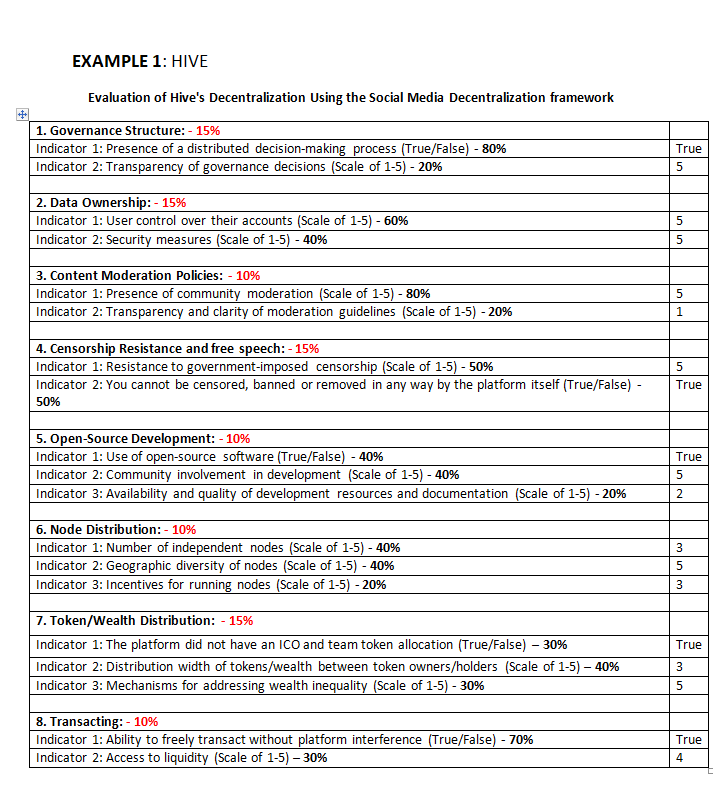
Governance Structure: - 15%
Indicator 1: Presence of a distributed decision-making process (True/False) - 80% True
Indicator 2: Transparency of governance decisions (Scale of 1-5) - 20% 5Data Ownership: - 15%
Indicator 1: User control over their accounts (Scale of 1-5) - 60% 5
Indicator 2: Security measures (Scale of 1-5) - 40% 5Content Moderation Policies: - 10%
Indicator 1: Presence of community moderation (Scale of 1-5) - 80% 5
Indicator 2: Transparency and clarity of moderation guidelines (Scale of 1-5) - 20% 1Censorship Resistance and free speech: - 15%
Indicator 1: Resistance to government-imposed censorship (Scale of 1-5) - 50% 5
Indicator 2: You cannot be censored, banned or removed in any way by the platform itself (True/False) - 50% TrueOpen-Source Development: - 10%
Indicator 1: Use of open-source software (True/False) - 40% True
Indicator 2: Community involvement in development (Scale of 1-5) - 40% 5
Indicator 3: Availability and quality of development resources and documentation (Scale of 1-5) - 20% 2Node Distribution: - 10%
Indicator 1: Number of independent nodes (Scale of 1-5) - 40% 3
Indicator 2: Geographic diversity of nodes (Scale of 1-5) - 40% 5
Indicator 3: Incentives for running nodes (Scale of 1-5) - 20% 3Token/Wealth Distribution: - 15%
Indicator 1: The platform did not have an ICO and team token allocation (True/False) – 30% True
Indicator 2: Distribution width of tokens/wealth between token owners/holders (Scale of 1-5) – 40% 3
Indicator 3: Mechanisms for addressing wealth inequality (Scale of 1-5) - 30% 5Transacting: - 10%
Indicator 1: Ability to freely transact without platform interference (True/False) - 70% True
Indicator 2: Access to liquidity (Scale of 1-5) – 30% 4
CALCULATION:
Governance Structure:
Indicator 1 = 5 (True)
Indicator 2 = 5
Category Score: (5 * 0.8) + (5 * 0.2) = 5
Data Ownership:
Indicator 1 = 5
Indicator 2 = 5
Category Score: (5 * 0.5) + (5 * 0.5) = 5
Content Moderation Policies:
Indicator 1 = 5
Indicator 2 = 1
Category Score: (5 * 0.8) + (1 * 0.2) = 4.2
Censorship Resistance and free speech:
Indicator 1 = 5
Indicator 2 = 5 (True)
Category Score: (5 * 0.5) + (5 * 0.5) = 5
Open-Source Development:
Indicator 1 = 5 (True)
Indicator 2 = 5
Indicator 3 = 2
Category Score: (5 * 0.4) + (5 * 0.4) + (2 * 0.2) = 4.4
Node Distribution:
Indicator 1 = 3
Indicator 2 = 5
Indicator 3 = 3
Category Score: (3 * 0.4) + (5 * 0.4) + (3 * 0.2) = 3.8
Token/Wealth Distribution:
Indicator 1 = 5 (True)
Indicator 2 = 3
Indicator 3 = 5
Category Score: (5 * 0.3) + (3 * 0.4) + (5 * 0.3) = 4.2
Transacting:
Indicator 1 = 5 (True)
Indicator 2 = 4
Category Score: (5 * 0.7) + (4 * 0.3) = 4.7
TOTAL: (5x0.15) +(5x0.15) +( 4.2x0.1) + (5x0.15) + (4.4x0.1) + (3.8x0.1) + (4.2x0.15) + (4.7x0.1)= 4.59
HIVE SCORE: 91.8% (4.59/5)
PS: Missing a developed methodology on determining the range on the scale 1-5 for various indicators. Once platforms are input and compared, benchmark values can be set for, ex. “Liquidity access”,” token distribution”, etc.
Once more results are presented thresholds for decentralization can be determined.
OUTRO:
For each of the platforms assessed using this framework, a breakdown of each indicator and category would have to be made, as is the case with Hive here in the example.
I obviously did not do that as this post would be double the size. My goal was to show that an Index accurately quantifying the decentralization level in crypto social media platforms/protocols is possible and should be created as a way to protect investors and users themselves.
First step, make some nice looking graphics out of this. Everyones making indexes, we can as well. At least I think this one makes sense.
I and happy to serve as inspiration for this with the decentralization matrix and I think this is a great methodology and framework for scoring platforms :)
😉
This is a great start. I’m trying to be constructive here. I’d just like to clarify, the highly limiting, historical use of the word platform for hive. It really is a travesty since it is certainly not a platform and has confused the pants off of almost everyone in the industry to the tremendous detriment of hive itself.
Steemit.com and steem were also inaccurately both referred to as platforms.
Steemit.com was a platform. Steem was a blockchain protocol upon which other permission less platforms could be built
I think, even to this day this is why people still call hive a platform. It’s really bad for hive and as a community we must make sure that hive is NOT referred to as a platform, especially in such potentially viral wider industry reviews.
If you are going to categorise things in this way you need a separate set of rules for social media blockchain protocols and a separate set of criteria for web3 platforms. (Or at least the web2.5 ones trying to call themselves web3)
One of the criteria for a platform maybe wether or not it uses a censorship resistant, decentralised protocol for its back end. Platforms such as hive blog, peakd, ecency, Leo finance (the platform), Veews, actifit, 3speak and others on hive meet this criteria. Others that do not use hive do not meet this criteria and therefore probably shouldn’t even be called fully web3.
This review should first start by categorising and ranking the existing social media blockchain protocols (or similar nomenclature) and then include that review into the scores of a separate review specifically for so called social media, web2.5-web3 platforms.
The protocols are often distinguished as decentralised or not based on the extent to which they can be regulated and shut down. The presence of VC backed Pre mines, ICO’s, CEO’s and companies behind social media blockchain protocols generally are key indicators and criteria as to wether or not they are decentralised. Ability for non tech people to earn the token via a fair playing feild distribution mechanism such as POB should also be a key criteria. I see you have somewhat addressed this in section 7. But this is simply not applicable to platforms, only to social media blockchain protocols.
That was added under wealth distribution.
Depends how the platform uses the blockchain tech, to what extent, for what exactly.
You cant split them in Web2.5 and web3. If you wanted to do that you would not only have to develop a methodology to determine what web2, web2.5, web3 is, but you would then have to draw a line where you can objectively say something is web3 or not.
Since web2.5 exists in your view, that shows that you cant draw that line, thats why the 0.5 is there.
Those are vague terms, that dont really mean anything, or rather mean many different things to many different people, but what you can do is develop a framework to judge them on the same basis.
Decentralization categories can be objectively set and determined for each, lets call it, "project".
I did put in platform/protocol in the title for that reason but "platform" is a colloquial term used by the public not really going in-depth over the meaning of the word.
Its kind of how the word "theory" is used in the mainstream circles. The colloquial meaning being: "Something that is of low certainty" while in actuality when something is described as a "theory" it is the highest possible level of explanation there is.
In the same way I think "platform" is used.
This approach could be expanded and not only cover social media related protocols and platforms. These categories selected could apply to any crypto related project to determine its level of decentralization with minor tweaks. Most of these categories apply universally.
The question is what is the goal, what do you want to show.
Going beyond social media, a decentralization index encompassing all projects could have even wider application.
That is a literal science paper worth a PHD thesis.
Sure stuff! I think u mostly used the word platform when I read it. Referring to hive as a platform is incredibly limiting to hive. Imo, It has significantly damaged its brand over the years.
I think its mostly because the biggest frontends rarely, if ever do anything beyond the features built into Hive. Some examples aside.
But we can start calling it a protocol, i dont think it would be a too big of a shift nor do I think most people would feel any significant shift in their view of things.
When I read this, I took it as applying to Hive.blog rather than Hive the blockchain. I would say that Hive.blog is a platform, on par with Ecency, 3Speak, etc. But the blockchain is definitely a protocol. Maybe the answer is to clarify that your framework is applicable to Hive.blog and not the blockchain, since the blockchain is the primary tool that powers the platform.
I think it’s critical not to call hive a platform. Peakd and 3speak are platforms
He might even let u know who reminded him about ur excellent work ;)
I still remember some of your posts about this!
Think you caught a few aspects that I missed in my broader and shallower index that I proposes here. And I think I captured a few aspects that could make a combined index a good idea. I especially think your index lacks a bit of growth perspective towards chains like HIVE, and as such is a bit to kind on HIVE for the things it hasn't addressed yet.
It's overall a deeper thought through set of parameters than my more shallow and general (but broader) one.
Ideally for example name-resolution and front-ends could and should be more decentralized, the same as IMHO part of the side-chain eco-system, especially in an economic sense.
Maybe you (we?) could try to patch your index with a deeper analysis of the four higher level concepts in my index.
Further, I'dd be interested to know why 1,2 and 6 have a higher weighing factor, and why you choose not to treat the components as a vector in the calculation of the final metric.
But apart from that, a great article.
This index framework lacks a bit more than that, lol. The problem with writing a paper like this is that you fall into a rabbit hole very easily. You write to explain and it opens more things to explain.
Its static. The methodology for determining categories would have to be developed and adjusted towards the goal of the index. What is it that we want it to show?
I just picked the most obvious categories.
The indicators as well would need to be researched etc. I wanted to show that this could be done.
Because its a 5 page paper that was written in a few hours and I simply didnt spend the time thinking about these things. 😄
It was a burst of inspiration.
I heard that on the https://londonblockchain.net/en <-- Charles Hoskinson wants to lead a panel on this topic. It's about time that we all look deeply into the Abyss.
Thats his way of lifting up Cardano above the nonsense of crypto right now. hes pumping money directly into "scientific research" on various topics to differentiate his chain from the noise. Its as much of a marketing gimmick as it is a valid approach.
Im no scientist but I can recognize the value in such in-depth coverage of certain topics that are at the core of this space and degens simply dont care about.
We used to have a strong Stem community, why not utilize their knowledge for the same thing?
It's been really something over the last couple of years. From ICOs, to massive DeFi on BSC and NFTs on Solana or OpenSea, literally, none of them have anything decentralized working for them. Charles knows about his own shortcomings and that's why he needs to put a panel in charge. There is a lot of history of failure already. Time to recap, draw conclusions and put a coherent vision out into the world.
The way you went ahead and made this scoring system is very delicious.
Using this tool the score for Steem for example would be around.
47% or lower
Steem is already dead as the posts there are not interesting and people are posting there only for milking the rewards.
Great framework to start on.
Hoping this can be included on books about decentralization of networks and social media.
I wouldnt go as far as that but I feel this could be a basis for a scientific paper someone more scientifically inclined might want to do.
I mean Cardano is throwing out scientific papers about Cardano left and right. Why wouldnt someone do a decentralization index scientific paper on Hive.
This maybe something that @trostparadox may be interested in as he is a high ranking member of OS university and this sounds like university research to me with which he can make an ethical, moral mark on the industry
Thanks for bringing this to my attention. Yes, this would definitely be worth looking into from an academic perspective.
Organization Science is a prestigious journal in the management field where a peer-reviewed article on this concept might fit well.
I will reach out to a few of my colleagues to get their input.
That is something that could be a basis for a website similar to price trackers like CMC, or Coingecko that would provide valuable input on decentralization levels for various projects in this space, even beyond social media related projects.
Im not great at writing papers😂 but would be more than willing to do the networking for you guys to get that funded.
Having a scientific framework to determine decentralization level, i feel is immensely valuable.
Everything we do on Hive should have impact beyond Hive. That is the path I try to take with anything I do.
If I recall there was a site made by a hivean for this @uncklebonehead, was that u?
It would need to just be about the decentralization index. Show nothing else. A story built about that and not only a footnote somewhere. Nothing can compete with CMC or coingecko.
But a whole new, metric specific site would have no competitor.
You are very much right there.
Hive is one for the books!
Yo this is great, you're now officially on a killing spree!
❤️
looks pretty cool and promising, well done
Congratulations @lordbutterfly! You have completed the following achievement on the Hive blockchain And have been rewarded with New badge(s)
Your next target is to reach 9000 replies.
You can view your badges on your board and compare yourself to others in the Ranking
If you no longer want to receive notifications, reply to this comment with the word
STOPCheck out our last posts:
Support the HiveBuzz project. Vote for our proposal!
@tipu curate
Upvoted 👌 (Mana: 56/66) Liquid rewards.
This is a great start. My initial thoughts are these:
Otherwise, this is really stellar work. I'd like to see it developed some more.
I consider myself a newbie on Hive both the protocols and the platforms thing but I was so intrigued with the misinterpretation of decentralization and for a user like me, it is a big help to at least understand what it really meant.
The tools you provided will help determine certain projects' decentralization levels. I am not a researcher, just an ordinary reader who wanted to learn more about Hive.
This is outstanding work. I think it also helped me learn more about the aspects involved in general assessment of blockchains for public usage.
@brianoflondon we spoke a couple of months back regarding the decentralized nature of Hive, and I recall you answered a bunch of my newbie questions. I've looked deeper into the topic both within and outside of Hive, and today found this post. This is a fantastic framework which I think would help answer people's concerns (although I can't say for sure how biased the proposed framework is towards Hive... but credit for thinking of and writing this in only 4 hours!).
Thanks for the knowledge and insight, @lordbutterfly! 😊